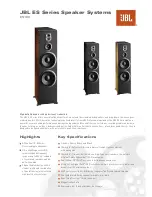
Self Regulating Heating Cable
© BriskHeat
®
Corporation. All rights reserved.
17
Marking
Install “Electric Trace” signs on alternate sides of the piping at regular intervals, as a warning to maintenance personnel. Permanently mark the outside of the insulation
lagging with the location of heating cable components. This will facilitate maintenance in the event of a problem.
THERMOSTATS & SENSORS
Temperature sensitive applications will require the use of a thermostatic control. Selection of the proper thermostat must consider voltage and amperage ratings of the device
as well as the suitability of housing for the environment (explosion proof, rain tight, corrosion resistance, etc.). Thermostat housing should be mounted as close as possible to
the power connection kit. It may be attached to the power connection kit provided code requirements are met with regard to conduit connections seals, etc. To sense the
coolest air temperature, ambient (air sensing) thermostats should be mounted in the shade when possible. When using pipe-sensing thermostats, the bulb (sensor) should be
mounted on the opposite side of the pipe from the heater, or as far away as is practical. This will allow the thermostat to sense the actual pipe temperature and not be
influenced by the heater temperature. Mount the bulb at least three (3) feet from the closest heat sink if possible.
Moisture inside the enclosure will cause both corrosion and electrical shorting problems. The potential for this type of problem can be greatly reduced by:
Proper sealing of all enclosures openings.
Keeping enclosure cover closed and secured as mush as possible during installation sequence.
Proper closing and sealing of the cover to prevent leaking into the housing.
Use of a moisture proofing/electrical spray (aerosol) sealant on thermostat and electrical connections (including all metal parts) at completion of installation.
Connection and use of space heater if thermostat is so equipped.
Do not de-energize space heater during summer months.
ELECTRICAL REQUIREMENTS
Voltage Rating
Verify that the heating cable voltage rating is suitable for the service being used. 240 volt rated cables may be used from 208 to 277 volts, with an accompanying change in
power output.
THERMAL INSULATION
Pre-Installation Checks
Inspect the heating cable and components for correct installation and possible damage. In particular, verify that:
The proper extra amount of heating cable has been installed at each valve, flange, pipe support, etc. and that it is free from physical nicks, tears or gouging. Additional
cable beyond the specified amount at a heat sink is not a problem due to the self-regulation effect of the heating cable.
Connections, splices and end seals are correctly installed, including cable seals at power connection enclosures.
Ensure insulation is properly rated fir the maximum edxposure temperature of the heated system.
Installation
Check the thermal insulation type and thickness against the design criteria. Changes in insulation type or thickness may require a different wattage heating cable. Verify that
all pipe work, including wall penetrations, fittings, etc. has been completely insulated.
Check the system to verify that:
Insulation is not wet from rainfall prior to the application of waterproofing.
Lap joints on vertical piping are properly overlapped - higher piece lapped over the top of lower piece.
Band seals are used at lap joints to prevent the ingress of water.
All penetrations of lagging (valve stems, hanger rods, etc.) are properly water proofed.
Irregular shaped items (i.e. pumps, etc.) are properly waterproofed.
To minimize potential damage to the heating cable, install the insulation as soon as possible. It is recommended that another insulation resistance (megger) test be done after
the insulation has been installed to verify that the heating cable was not damaged during the insulation installation.
Self Regulating Heating Cable
© BriskHeat
®
Corporation. All rights reserved.
18
Maximum Circuit Length in Feet Vs. Circuit Breaker Size
Heat Cable
Type
Circuit
Breaker
Size
Start-up Temperature
50°F
(10°C)
0°F
(-18°C)
-20°F
(-29°C)
SLCAB3120
15 amp
300
200
180
20 amp
-
270
230
30 amp
-
330
330
SLCAB3240
15 amp
660
410
360
20 amp
-
560
480
30 amp
-
660
660
SLCAB5120
15 amp
230
150
130
20 amp
270
200
175
30 amp
-
270
260
SLCAB5240
15 amp
460
300
260
20 amp
540
400
345
30 amp
-
540
520
SLCAB8120
15 amp
150
95
85
20 amp
200
125
100
30 amp
210
190
170
40 amp
-
210
210
SLCAB8240
15 amp
295
195
170
20 amp
390
250
225
30 amp
420
375
340
40 amp
-
420
420
SLCAB10120
15 amp
115
70
60
20 amp
150
95
85
30 amp
180
145
120
40 amp
-
180
165
SLCAB10240
15 amp
230
150
130
20 amp
305
200
175
30 amp
360
300
260
40 amp
-
360
360
Voltage Adjustment Factors
Power Adjustment Factor
Product Type
208 VAC
277 VAC
SLCAB3240
0.75
1.28
SLCAB5240
0.86
1.16
SLCAB8240
0.91
1.10
SLCAB10240
0.93
1.08
Electrical Loading
Size over-current protective devices shown in Figure 12 and 13. If devices are other than standard thermal magnetic circuit breakers,
consult factory.
(For installation in USA) All appropriatedly rated circuit breakers must be identified using a reference label indicating which branch
circuit supplies the circuits to the series heating cable sets.
SLCAB
Figure 12
Po
w
er Outp
ut,
W
/ft
Pipe Temperature, °F(°C)
12
10
8
6
4
2
0
Heat Output (Watts per Foot)
D = 10 W/FT
C = 8 W/FT
B = 5 W/FT
A = 3 W/FT
0 (-3)
50 (10)
70 (21)
90 (32) 110 (43) 130 (54) 150 (66)










































